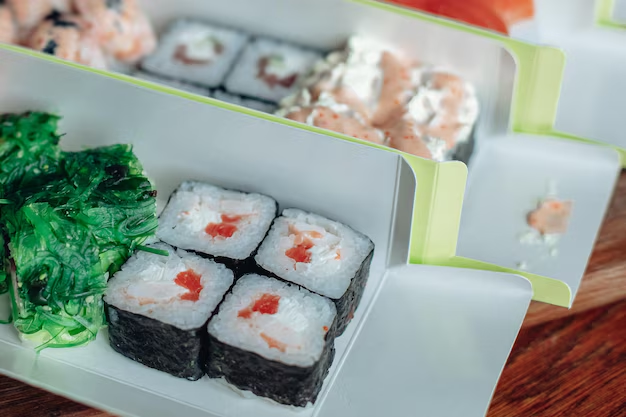How Fresh is Your Sushi? A Guide to Storing Sushi in the Refrigerator
When you think of sushi, images of elegantly crafted rolls and tantalizing nigiri likely come to mind. But what happens when you have leftover sushi? Understanding how long sushi stays fresh in the refrigerator is crucial for both your health and taste buds. Let’s delve into the essentials of sushi storage and maximize your sushi dining experience at home.
🥢 What Makes Sushi Perishable?
Sushi is a unique blend of ingredients, each with its own perishability factors.
Key Components of Sushi
- Fish and Seafood: These are the most critical factors in determining sushi's longevity. Freshness is paramount, and seafood tends to spoil quickly.
- Rice: Sushi rice, while less prone to rapid spoilage, loses its texture and flavor over time.
- Vegetables and Other Ingredients: Items like avocado or cucumber add variation but have different rates of spoilage.
Each component requires careful handling to ensure your sushi remains safe and pleasurable to eat.
🕒 Understanding Sushi Shelf Life
Not all sushi is created equal in terms of how long it can be stored. Let’s break it down by type:
Nigiri and Sashimi
Nigiri and sashimi consist of raw fish, making them the most perishable types of sushi. Stored properly in an airtight container, they typically remain good for up to 24 hours in the refrigerator. Beyond this point, both texture and safety are compromised.
Maki and Other Rolls
Rolls with cooked fish or vegetables have a slightly longer shelf life. They can last up to 48 hours when refrigerated. The presence of rice and other ingredients helps extend longevity, but the freshness of the fish remains a factor.
Store-Bought vs. Homemade
Store-bought sushi often contains preservatives to extend shelf life, especially in packaged varieties. However, it’s still best consumed within 24-48 hours upon opening. Homemade sushi should follow the same guidelines as the freshest option is always best.
🔑 Tips for Storing Sushi Properly
To extend the shelf life of sushi and maintain its quality, adhere to these storage practices:
- Refrigerate Promptly: The quicker you refrigerate sushi after purchase or preparation, the better.
- Use Airtight Containers: Prevent exposure to air to minimize drying out and bacterial growth.
- Temperature Matters: Keep your fridge at 4°C (39°F) or colder to ensure optimal preservation.
- Separation of Elements: If possible, store fish separate from rice to slow down spoilage.
- Avoid Freezing: Freezing sushi significantly alters its taste and texture, rendering it unappealing.
🍣 Recognizing Spoiled Sushi
Consuming spoiled sushi can lead to foodborne illnesses. Be aware of these indicators that your sushi has gone bad:
- Off Smell: A sour or fishy odor indicates spoilage.
- Changed Texture: Fish becomes slimy or rice grows hard and dry.
- Color Alterations: Discoloration, especially in the fish, suggests it's time to discard.
If in doubt, the safest option is to dispose of the sushi.
👩🍳 Making the Most of Leftover Sushi
While fresh sushi is always best, creativity can breathe new life into leftovers.
Repurposing Leftovers
- Sushi Bowls: Transform leftover sushi into a sushi bowl by mixing with fresh vegetables and a light dressing.
- Fried Rice: Incorporate leftover sushi ingredients into a delicious fried rice dish.
- Soups and Broths: Add sushi components to broth for a flavorful twist.
✅ Quick Reference Guide: Sushi Storage Tips
Here’s a succinct guide to help you quickly grasp how to handle your sushi leftovers effectively:
| Type of Sushi | Refrigerated Shelf Life | Key Storage Tips |
|---|---|---|
| Nigiri/Sashimi | Up to 24 hours | Use airtight containers, refrigerate promptly, monitor for spoilage |
| Maki/Rolls | Up to 48 hours | Refrigerate quickly, avoid exposure to air, keep temperature consistent |
| Store-Bought | Follow packaging, typically 24-48 hours | Check expiration, store immediately after opening |
| Homemade | Same as Nigiri/Sashimi | Prioritize freshness, separate storage for rice and fish |
Essential Notes:
- Always prioritize food safety. When in doubt, throw it out. 🤔
- Experiment with creative uses for leftovers to reduce waste.
🛡️ Final Word on Food Safety
Balancing taste and safety is key when dealing with sushi leftovers. By understanding perishability, practicing proper storage, and recognizing signs of spoilage, you can enjoy your sushi with confidence.
The art of sushi is as much about savoring its freshness as it is about respecting its delicate preservation needs. Treat your leftovers mindfully, and you’ll always be rewarded with a delightful, safe dining experience.
